
by Ryan Grim
As we stepped through the side door of a long chicken house on Maryland’s Eastern Shore, thousands of birds tried to scatter. Scattering, though, was not an option for any one of these 30,000 chickens packed into a house 500 by 50 feet long. Much like blue crabs rustling in a bushel, they bounced off each other for a frightened moment. Then they settled and returned to their favorite pastime, rhythmic head-bobbing.
Toward the end of the house we could see the silhouettes of a Mexican crew, the chicken catchers, each man grabbing two or three chickens at a time and chucking them into crates bound for Salisbury, the next stop in their inexorable journey toward a Monday night 25-cent wing special.
These birds, it turns out, would be tossed onto the truck in the nick of time. It takes five catchers about three hours to toss and cage each living bird — the dead ones are left to rot — on the Salisbury-bound trucks.
Three days later, on March 8, a second outbreak of avian influenza would rock the Maryland poultry industry, sending hundreds of thousands of these birds’ brethren to untimely graves, costing farmers thousands and spreading fears through and about the Eastern Shore’s $1.5 billion poultry industry.
 |
|
photo by James Sappington
|
The night of the pick-up, the farmer — call him Charlie — my photographer and I stayed back and hopefully out of sight. Charlie’s concern had nothing to do with bird flu, which at the time was thought to have been stopped in its tracks on two farms in Delaware. His fears were more political.
Charlie was afraid the crew would tell his “integrator,” the agricultural behemoth Perdue, that he had allowed a reporter on his farm.
Over the last 80 years chicken farming on the shore has gone from a backyard hobby to the cornerstone of the region’s economy. Three large companies, called integrators, tightly control the industry from the egg to the house to the fryer. By owning and integrating the feed industry, the fuel industry, the processing plants, the research laboratories, the trucks, the catchers and even the birds themselves (farmers don’t own their chickens, but rather grow them), the integrators can exert control over price, maximize profitability and insulate themselves against risk.
The return to the farmers is just enough to get by from one season to the next. Most farmers run fewer than five houses and net less than $4,000 per house per year. Profit tends to be eaten up by capital investments to keep up with the industry’s shifting requirements. If they don’t keep up, they can’t compete. Now, for example, many farmers are widening and shortening their long, narrow houses to accommodate a third feed line. No matter what the farmers want to do, there’s no wiggle room for environmental innovation or responsibility.
Trouble Roosts Here
Each year, six hundred million birds live and die on the Delmarva Peninsula — but not without leaving behind an environmental legacy.
The vast tons of manure these birds produce in their short lifetimes makes for an equally vast disposal problem. Much of it is spread as fertilizer on fields, the vast majority of which grow feed for the chickens.
 |
|
photo by James Sappington
|
Nutrients from this runoff, according to Jeff Welsh at the Maryland Department of the Environment, account for roughly one-third of all nutrient pollution in the Bay. The Chesapeake Bay Program puts the number at 43 percent for phosphorous and 38 percent for nitrogen. Either way, at between 100 and 130 million pounds of nutrient, we’re talking about a lot of manure.
Nutrient pollution — from treated sewage and auto and truck exhaust as well as farm fields — is a leading cause of the decline in Bay water quality. As often that is measured by the accompanying decline in Bay life. But in 1997, Chesapeake Country witnessed the problem in a memorably graphic way.
Scientists are nearly unanimous in pointing toward chicken manure as the cause of the infamous Pfiesteria outbreak of that year. Pfiesteria killed hundreds of thousands of fish, sickened watermen, damaged tourism, crippled fish sales and closed several rivers.
Jack Greer, assistant director of the Maryland Sea Grant College, which studies Pfiesteria extensively, explains that the relationship between nutrient enrichment and Pfiesteria is complicated. Still, he says, chicken manure “is still the best guesstimate” of the cause of that outbreak. “It’s pretty well agreed that increased nutrients are likely to create the conditions where Pfiesteria is likely to appear.”
Seven years after that outbreak, the harshest environmental critics say the Bay is dying of over nutrification.
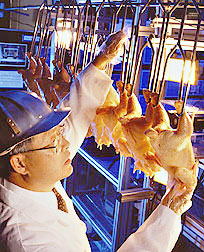 |
|
photo courtesy of USDA
|
We didn’t last long in Charlie’s dimly lit chicken house: The word stench doesn’t come close to describing the overpowering blast of dusty ammonia that seeps into eyes, throat and lungs. Within a few minutes, no more than 10, Charlie turned to us with his shirt over his mouth to mumble, “Guys, I can’t take it anymore.”
As the door closed behind us, I realized that these chickens had spent the last eight weeks — essentially, their lifetimes — in a squalor we couldn’t stand for 15 minutes. Yet we’re surprised when disease breaks out.
“When you have an enormous number of birds in disgusting conditions, you’re setting yourself up for some really horrible things,” says Robert Sprinkle, a physician and associate professor of public policy at the University of Maryland School of Public Affairs. “You can really get creamed.”
This most recent case of bird flu broke out first in Delaware and then, independently, in Maryland, according to Maryland Department of Agriculture officials. Why? We’ll probably never know. But generally the Eastern Shore’s poultry industry is ripe for such disasters.
Avian influenza and other epidemics are part simple, part complex. Whenever a species is packed densely together in squalid conditions, there is a high risk for contagious disease wiping out nearly the entire population.
To guard against catastrophic epidemics, farmers heavily vaccinate their flocks just as we vaccinate ourselves. That’s an imperfect solution, as many of us know. Vaccination can only defend against strains of the virus from which that vaccine was developed. Farmers, like all flu vaccine users, can only hope that the strain of virus that comes around is the one they have vaccinated against.
Antibiotics and antimicrobials, heavily applied as insurance against other diseases, come with problems as well. Their very success encourages the evolution of disease, as only the fittest bacteria live and reproduce, passing their resistance to future generations. Next time around, farmers need stronger medicinal remedies. In a worst-case scenario, an outbreak wipes out chicken houses, locks down the Eastern Shore, closes the Bay Bridge and devastates Maryland’s economy.
This scenario is not a matter of prophesy, but a fair description of events that have already transpired, most notably in the Shenandoah Valley in 2002, where avian influenza wiped out 197 farms and five million birds. Unless changes are made, the future could see such occurrences with increasing regularity.
Jumping Species
In one critical way, the Eastern Shore dodged a bullet with the most recent Delmarva outbreak. The H7 virus on Maryland’s lower Shore is not the same one that swept through southeast Asia, jumping species and killing 23 people.
The next time avian influenza rears its ugly head on the Eastern Shore, there’s no guarantee it won’t be a form that jumps to humans. The avian flu virus that hit the Eastern Shore this winter spreads like the common flus we’re used to — airborne and passing from host to host. So too does the strain in southeast Asia. These viruses not only mutate but are also capable of traveling great distances.
The International Society for Infectious Diseases reported March 19 that research by Japan’s National Institute of Animal Health has shown that the “gene sequence of the bird flu virus found in Japan and that found in South Korea are virtually the same.” Many international experts claim that the virus was carried by migratory birds, but there is no way to prove a direct connection.
Perdue spokeswoman Tita Cherrier agrees with Maryland officials who cite migratory birds as the likely cause of Maryland’s outbreak. Again, proving or disproving such a claim is next to impossible.
Some flu strains jump species to humans and some do not, but by varying degrees each punishes the Eastern Shore economy and threatens to alter a way of life. The February and March outbreak, compared to its potential consequences, was mild. In Maryland, only one farm has so far been infected. But 368,000 birds on three farms owned by one unlucky farmer — a fraction of the total birds on the shore — were “euthanized” in their houses to prevent the infection’s spread.
As this outbreak of avian influenza dies down, leaving chickens and farmers its only victims, dare we wait for more serious consequences before asking the Delmarva poultry industry — and ourselves — some hard questions? For public policy professor Sprinkle, this outbreak sent a clear message: Now is the time to re-examine farming practices on the Eastern Shore.
The Avian Flu Express
In the meantime, avian influenza spreads across the globe. Cases continue to be reported in southeast Asia and have spread as far as India and Japan. British Columbia, too, has seen a second outbreak after they thought it was contained, resulting in the preventive slaughter of 36,000 birds. The Netherlands, too, has gassed 22,000 chickens to contain an outbreak.
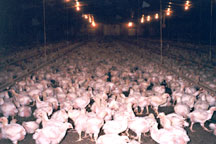 |
|
photo by James Sappington
|
Serious enough for federal government and poultry industry officials to expand testing for avian influenza to cover most of the poultry raised in the United States, possibly beginning as early as March 29, according to the U.S. Department of Agriculture. This $12.5 million program would focus on the most dangerous forms of avian influenza, H5 and H7. These diseases can, according to the International Society for Infectious Diseases, “be no worse than the chicken equivalent of the common cold. If left to spread, however, they can mutate into highly pathogenic varieties that can kill entire flocks in a day.”
Hooked on Chicken
For Charlie, flu and all it brings — including chicken inspectors — makes a hard job harder.
“Here’s what sums it up for me,” Charlie said. “The other day the guy who’s in charge of controlling the outbreak came up here to test my chickens. He had just come from the two infected farms in Delaware and drove the same truck up here. What kind of sense is that?”
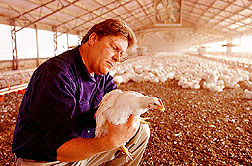 |
|
photo courtesy of USDA
|
One of the biggest problems with chicken farming on the Eastern Shore, however, is that much of it, in the short run, does make sense. Farmers, even though they generally just scrape by, continue to farm because they’ve already sunk so much capital into the venture that getting out is financially impossible.
At the same time, universally vaccinating and pumping birds full of antibiotics is a farmer’s version of the precautionary principle. Why not? It can’t hurt — never mind that with a virus like avian flu it can’t help.
The same principle applies to the spreading of chicken litter for fertilizer.
For the farmer there is no risk in over-fertilizing (other than legal risks); whatever the crops don’t take up simply runs off the farm. There is a risk, however, in under-fertilizing. A difference in tons of soybeans at harvest adds up, and a light year can be devastating for the typical farmer living year-to-year, sporadically dipping into and out of the red ink.
Other than Charlie, the farmers who would talk — few for attribution — expressed sympathy for the views of environmentalists. But they say they’re stuck.
Controlling the Coop
With each disaster, policy progress may or may not be made. Following the Pfiesteria outbreak, as fish bobbed up and tourism sank, lawmakers looked hard at the chicken industry and finally — despite Big Chicken’s best lobbying efforts — assigning them accountability.
That logic held until Robert Ehrlich moved into the governor’s mansion. Six months into his term, Ehrlich announced that the state would abandon rules that hold poultry giants accountable for pollution.
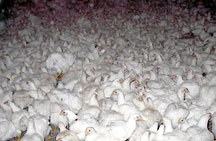 |
|
photo by James Sappington
|
“Take McDonald’s restaurant. To make those independent operators responsible for the behavior of McDonald’s, or to make McDonald’s responsible for the behavior of its independent operators, is ludicrous,” said Satterfield. “It is beyond the scope of law. It just didn’t make sense. In the end reason prevailed.”
When the governor, whose campaign received a $150,000 contribution from the poultry industry, made the announcement, he added that he plans to “develop innovative solutions that clean up the Chesapeake Bay while allowing chicken processors and farmers to earn a living without excessive government intrusion.”
Without excessive government intrusion, the poultry industry — on the Eastern Shore and across the nation — runs as a near monopoly. Perdue and a few other poultry companies dictate Eastern Shore farm policy and practices. They tell farmers how much poultry to grow, when they’ll pick it up and how much they’ll pay for it.
There is nothing new or unusual in this way of business. Indeed, Mr. Perdue would be negligent in the eyes of his shareholders if he didn’t do all in his power to increase share price and company revenues. Brian Barnes, who with his father runs four houses on the Upper Shore, says, “You’ve got to admire him. He’s a hell of a businessman. He doesn’t miss a penny if he can squeeze it out.”
For example, farmers say, Perdue has begun buying surplus manure, but for less than a farmer can get from another farmer. The twist is that farmers aren’t buying from each other anymore; they are only buying from Perdue because, thanks to its buying power, it can turn around and sell more cheaply.
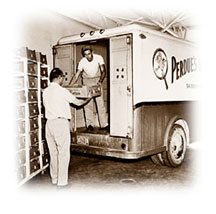 Perdue’s Tita Cherrier sees it differently. In fact, she says, Perdue pays nothing at all, but “provides the service of removing the manure from the farm premises free of charge.” As part of its AgriRecycle program, Perdue converts this manure into fertilizer pellets and sells it across the country.
Perdue’s Tita Cherrier sees it differently. In fact, she says, Perdue pays nothing at all, but “provides the service of removing the manure from the farm premises free of charge.” As part of its AgriRecycle program, Perdue converts this manure into fertilizer pellets and sells it across the country. As Barnes tells it, Perdue’s recent foray into the manure business is just its latest move to dominate agriculture on the Eastern Shore.
Bound for the Table
As we drove away from Charlie’s chicken farm in the dead of the March night, we started to see what looked like flurries of snow. Speeding up, we saw that the flakes had their source not in the clouds but in the loaded tractor-trailer up the road. Bound for Salisbury, these birds were now seeing the sky, dark as it was, for the first time in their lives. Having escaped bird flu, they were due for dinner.
At the next intersection, a truck carrying the fate of the Eastern Shore banked off to the left, its flurry of feathers coating the road in its wake.
Last updated March 25, 2004 @ 2:37am.

